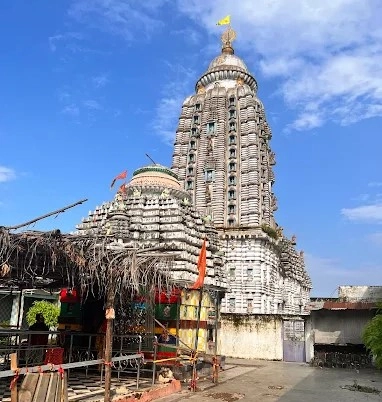
Table of Contents
India is a land of powerful goddesses. When it comes to Shaktism, Odisha holds a special place. Among the sacred Shakti Peethas, one temple stands out. It is known not only for its spiritual aura but also for its Tantric connections. This is the Bhairavi Temple of Mantridi, located near Berhampur in southern Odisha. In this blog, let’s explore the legend, architecture, rituals, and spiritual importance of Bhairavi. Discover why this ancient deity continues to mesmerize seekers and pilgrims alike.
The Power of Shaktism in Odisha
Devotees have long revered Odisha as a sacred land for Shakti worship. According to the Kalika Purana, moreover, traditions recognize it as one of the four most important regions for the Shakti cult, alongside Jullundur (Punjab), Srimukhalingam (Andhra Pradesh), and Kamarupa (Assam). Here, devotees worship goddesses like Chandi of Cuttack, Viraja of Jajpur, Bimala of Puri, and Samaleswari of Sambalpur with great devotion. Among them, devotees especially revere Siddha Bhairavi of Mantridi for her unique form, mood, and legend.
Where Is Bhairavi Temple Located?
You’ll find the Bhairavi Temple in Mantridi village, about 15 km from Berhampur and 5 km from Golantra, just off National Highway No.5. Moreover, the temple sits serenely within a sprawling 20-acre complex filled with lush gardens of coconut, Ketaki, and Champa trees. From there, each step—from the first gate to the sanctum sanctorum—takes you on a spiritual journey into a realm of quiet power.
The Bhairavi Idol: Ekapada in Roudra Form
As you walk about 250 feet past the garden and pass the grand archway with Mahishasura Mardini, you descend 3–4 feet into the sanctum. There, embedded in stone, stands the idol of Bhairavi, carved from a single granite stone. Notably, this is no ordinary depiction—the goddess is known as Ekapada Bhairavi, meaning “one-footed Bhairavi.”
She holds a Trident and Sword in her upper hands, while her lower hands rest on her navel and the ground, signifying strength and grounding. Interestingly, water continuously sprinkles from her heart—a stream known to never dry up. Her form is fierce, and her presence is so powerful that it evokes both devotion and awe. Furthermore, this setting, along with a nearby burial ground, indicates a strong Tantric influence, making it a unique pitha among others rooted in Saktism.The Origin Story: From Forest to Faith
The temple’s origins are not formally documented, but a popular legend tells us that around 200 years ago, this area was dense forestland known as Hurudungo. While ploughing the land, a member of the Reddy family hit something unusual. Digging further, they discovered the deity of Bhairavi—with a visible plough mark still present on the stone! Moved by the divine discovery, they enshrined the idol and built the current temple.

Mythology and Connection to Parasurama
Some traditions believe that Parasurama, the warrior-sage and sixth avatar of Vishnu, meditated on Mehendragiri hill, not far from Mantridi. It is said he worshipped Bhairavi, further elevating the importance of this temple. If this legend holds true, the temple’s actual age might predate the Reddy family’s discovery by several centuries.
Rituals and Festivals at Bhairavi Temple
Although fewer people know about it compared to other temples, devotees turn Bhairavi Temple into a hub of ritualistic activity, especially during festivals:
- Navratri/Dasara: During this time, devotees carry the deity in a grand procession to Mantridi village and worship her there for nine days, offering prayers and devotion daily.
- Masanta Sankranti: Similarly, around 500 to 1,000 pilgrims visit the temple every month-end to mark Sankranti.
People Also Ask
1. What is the significance of Bhairavi Temple in Odisha?
Moreover, devotees revere Bhairavi Temple in Odisha for its Tantric traditions, unique idol, and strong local beliefs, all deeply rooted in mythology and spiritual practices.
2. Who discovered the Bhairavi idol at Mantridi?
Over 200 years ago, members of the Reddy family discovered the idol while ploughing forested land in the Hurudungo village area.
3. Why is the deity called Ekapada Bhairavi?
Because the granite idol stands on one foot and features four hands in a fierce stance—hence the name “Ekapada Bhairavi.”
4. Is Bhairavi connected to any mythological figures?
Yes, Parasurama worshipped Bhairavi, which links her to broader Vedic traditions.
5. When is the best time to visit Bhairavi Temple?
The temple sees the highest footfall during Dasara, Masanta Sankranti, and the Chaitra Jatra, making these ideal times to experience its spiritual vibrancy.
Why You Should Visit Bhairavi Temple
Visiting Bhairavi Temple is not just a religious act—it’s a walk into a living legend. Whether you’re a devotee, a history lover, or a seeker of Tantric mysticism, Bhairavi of Mantridi has something profound to offer. Indeed, the solitude, combined with the energy of the place, leaves an indelible mark on every soul who visits.
Plan Your Visit to Bhairavi Temple
Visit this Chaitra or during Dasara. Feel the power, absorb the silence, and let the goddess guide your path.
Already been there? Share your story and help others discover the magic of Bhairavi!

Pingback: Udayagiri & Khandagiri – Discover Odisha’s Ancient Jain Legacy
Pingback: Khandagiri Caves- Bhubaneswar: Jain Heritage & History